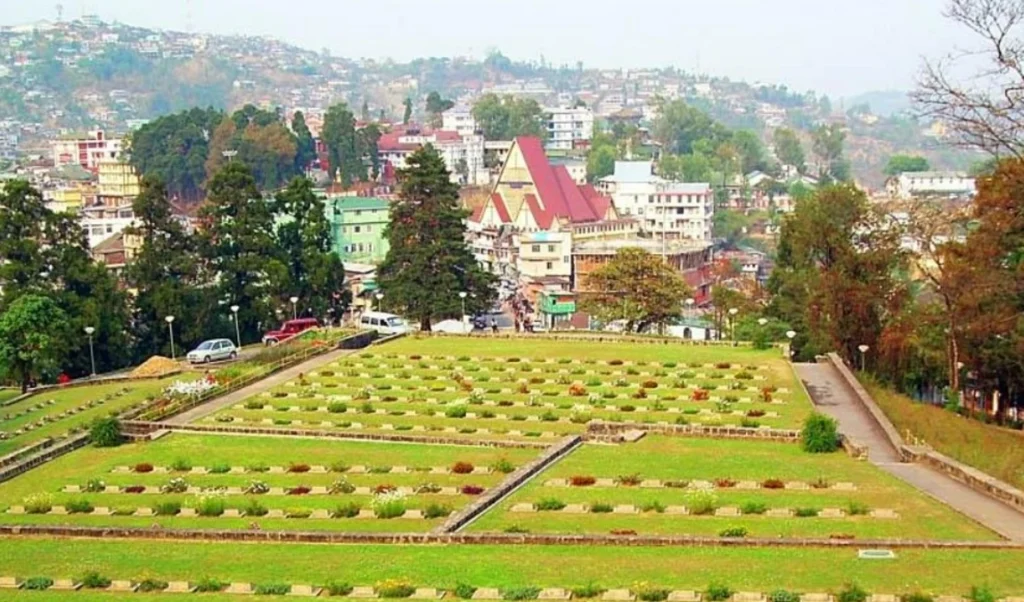Explore the rich heritage, scenic landscapes, and vibrant culture of Kohima District, Nagaland. Discover historic sites, festivals, and natural beauty!

Unveiling the Beauty & Heritage of Kohima, Nagaland!
Nestled in the northeastern region of India, Kohimaa District stands as an emblem of Nagaland’s rich cultural heritage and historical significance. Spread over an area of approximately 1,100 square kilometers, this district serves as the capital of Nagaland and is known for its breathtaking landscapes, vibrant indigenous cultures, and a storied past that continues to shape its identity.
Geography and Natural Beauty
Kohima District is situated at an elevation of 1,444 meters above sea level, offering a mild and pleasant climate throughout the year. The district’s picturesque terrain is adorned with lush green hills, dense forests, and meandering rivers that contribute to its scenic charm. The Dzükou Valley, often referred to as the ‘Valley of Flowers,’ is one of its crown jewels, boasting a stunning display of diverse flora and fauna.
Cultural Diversity
Kohima District is a melting pot of diverse Naga tribes, each with its unique customs, languages, and traditions. The district is inhabited by several prominent tribes, including the Angami, Chakhesang, Rengma, and Sumi, among others. These tribes are renowned for their vibrant festivals, intricate handwoven textiles, and distinct art forms, such as wood carvings and beadwork.
The Hornbill Festival, celebrated annually in December, is a grand showcase of Nagaland’s cultural mosaic. It brings together various tribes in a colorful extravaganza of dance, music, and traditional cuisine. Visitors get a rare opportunity to witness the essence of Naga culture and forge connections with the warm and welcoming locals.
Historical Significance
Kohima District played a pivotal role in the history of World War II. The Battle of Kohimaa (1944) was a turning point in the war’s Eastern Front. The Kohima War Cemetery and the War Museum serve as poignant reminders of this historic battle, where British and Indian forces defended the town against the Japanese army.
Tourist Attractions
Besides its cultural and historical significance, Kohima District offers a range of tourist attractions. The Kohima Cathedral, with its stunning architecture and panoramic views of the town, is a must-visit. The State Museum provides insights into Nagaland’s history, art, and tribal heritage.
Nature enthusiasts can explore the Japfu Peak, which is the second-highest peak in Nagaland, offering challenging trekking trails and breathtaking vistas. The Khonoma Green Village, known for its conservation efforts and sustainable living practices, is a shining example of eco-tourism in the region.
Challenges and Opportunities
While Kohima District boasts its cultural heritage and natural beauty, it also faces challenges typical of many remote regions. Infrastructure development, access to healthcare, and educational facilities are areas that require continued attention. However, the district’s potential for tourism, agriculture, and handicraft industries offers opportunities for sustainable growth and development.
Famous Places in Kohima District
Kohima District in Nagaland is replete with famous places that offer a captivating blend of culture, history, and natural beauty. Here are some of the standout attractions:
Kohima War Cemetery: A poignant reminder of World War II, this cemetery is a solemn place honoring the soldiers who lost their lives during the Battle of Kohima. It is beautifully maintained and offers a tranquil setting for reflection.
Kohima State Museum: This museum provides a comprehensive glimpse into Nagaland’s history, culture, and tribal heritage. Visitors can explore a diverse collection of artifacts, textiles, and traditional Naga art forms.
Hornbill Festival Grounds: Every December, Kohima comes alive with the Hornbill Festival, one of the largest celebrations of Naga culture. The festival grounds are a bustling hub of tribal dance performances, indigenous food stalls, and traditional craft exhibitions.
Kohima Cathedral: Also known as the Mary Help of Christians Cathedral, this stunning Catholic church offers panoramic views of the town. Its Gothic architecture and serene atmosphere make it a must-visit place in Kohima.
Dzükou Valley: Located near Kohima, the Dzükou Valley is often referred to as the ‘Valley of Flowers.’ It is a trekker’s paradise, adorned with a colorful carpet of diverse flora during the monsoon season.
Japfu Peak: As the second-highest peak in Nagaland, Japfu Peak is a challenging trekking destination. It rewards trekkers with breathtaking vistas and the opportunity to explore the mystical Japfu Rhododendron Sanctuary.
Khonoma Green Village: Known for its sustainable and eco-friendly practices, Khonoma is a model village for eco-tourism. Visitors can witness the conservation efforts and traditional Naga way of life while enjoying the natural beauty of the area.
Kohima Zoo: The Kohima Zoological Park is home to a variety of wildlife species, including the rare Blyth’s tragopan, a colorful pheasant species native to Nagaland. It’s an excellent place for wildlife enthusiasts.
Kisama Heritage Village: This village serves as the venue for the Hornbill Festival and is a living museum of Naga heritage. It features traditional Naga huts, cultural performances, and showcases the lifestyle of different tribes.
Doodle Wall: Located in the heart of Kohima, the Doodle Wall is a vibrant and ever-changing street art project that adds a splash of color to the town. It’s a unique and dynamic attraction for art enthusiasts.
These famous places in Kohima District offer a diverse range of experiences, from solemn historical sites to vibrant cultural festivals and the serene beauty of nature. They collectively provide a deep and immersive exploration of Nagaland’s rich heritage and natural wonders.
Read More :-
